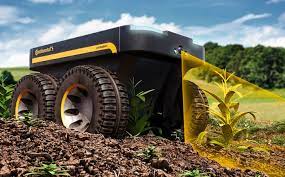How Robotics is Revolutionizing the Future of Agriculture
Introduction
As the world population continues to grow, the demand for food production also increases. However, with limited agricultural land, the challenge of producing enough food to feed everyone becomes even more pressing. To solve this problem, farmers need to find more efficient and sustainable ways of producing crops. Fortunately, advancements in robotics have opened up new possibilities for sustainable farming. This article will explore the benefits of using robotics in agriculture and how it is shaping the future of farming.
Benefits of Robotics in Agriculture
One of the primary benefits of robotics in agriculture is the ability to increase efficiency and productivity. Robots can perform tasks that are repetitive, time-consuming, and physically demanding, such as planting, watering, and harvesting crops. These tasks can be done quickly and accurately by robots, which reduces the amount of time and labor required by humans. This not only saves farmers time and money, but it also enables them to produce crops on a larger scale.
Another advantage of robotics in agriculture is that it can reduce the amount of waste and environmental damage caused by traditional farming methods. Robots can use sensors and imaging technologies to monitor crops and identify any issues early on. This means that farmers can take action before problems become more serious, such as using pesticides and herbicides in a more targeted manner. This not only reduces the amount of chemicals used but also decreases the risk of harm to the environment and human health.
Robots can also be used to manage the soil and improve its quality. For example, robots can be used to measure soil moisture, temperature, and nutrient levels. This information can be used to determine the best time to plant and irrigate crops, as well as identify areas of the soil that need improvement. This helps to ensure that crops are grown in the most optimal conditions possible, which can result in higher yields and better quality produce.

Impact of Robotics in Agriculture
The impact of robotics in agriculture has been significant, and it is continuing to grow. Farmers who have adopted robotic technology have reported increased productivity, reduced labor costs, and higher crop yields. For example, a lettuce farm in Japan was able to increase its lettuce production by 50% after introducing robots to its farming process. Similarly, a California-based company, Iron Ox, has developed a fully automated farm that can produce leafy greens all year round. These examples demonstrate the potential of robotics to revolutionize the future of agriculture.
Furthermore, robotics in agriculture can help to address some of the challenges that farmers face, such as the shortage of labor and the need for more sustainable farming practices. The use of robots can reduce the need for manual labor and provide a more efficient way of managing crops. Additionally, the use of sensors and imaging technologies can help farmers to identify issues with their crops early on, reducing the need for harmful chemicals.
Challenges and Limitations of Robotics in Agriculture
While robotics has the potential to revolutionize agriculture, there are still some challenges and limitations to consider. One of the biggest challenges is the high cost of robotics technology. Robots can be expensive to purchase and maintain, which can be a barrier for small-scale farmers. Additionally, robots require a significant amount of power to operate, which can be a challenge in areas with limited access to electricity.
Another limitation of robotics in agriculture is the need for specialized skills to operate and maintain the technology. Farmers who are unfamiliar with robotic technology may find it difficult to integrate it into their farming practices. Additionally, robots require regular maintenance and repair, which requires specialized skills and training.

Finally, robotics in agriculture may also have social and ethical implications to consider. The use of robots in agriculture may lead to job loss for human workers, particularly those who perform manual labor. Additionally, there may be concerns about the impact of automation on rural communities and the potential for a widening digital divide between urban and rural areas.
Conclusion
The use of robotics in agriculture has the potential to revolutionize the future of farming. With the ability to increase efficiency, productivity, and sustainability, robots are becoming an increasingly popular choice for farmers around the world. However, there are still challenges and limitations that need to be addressed, such as the high cost of technology and the need for specialized skills to operate and maintain robots. Additionally, the social and ethical implications of automation in agriculture need to be considered. Nevertheless, with continued advancements in technology, robotics in agriculture holds great promise for the future of sustainable farming.
As we move forward, it will be important to find ways to make robotics technology more accessible and affordable for small-scale farmers. Governments and private sectors can invest in research and development to create more affordable and sustainable robotic solutions that can be adopted by farmers of all sizes. This can help to promote inclusive growth and development in rural areas, while also addressing the challenge of food security.
Moreover, it will be essential to provide training and support to farmers to help them integrate robotic technology into their farming practices successfully. This can include providing education and training on how to operate and maintain the technology, as well as offering technical support when needed.
Finally, it is important to address the social and ethical implications of automation in agriculture. This includes considering the impact of job displacement on rural communities and finding ways to promote equitable growth and development. It also involves developing ethical guidelines and regulations to ensure that robotic technology is used in a way that is safe, responsible, and sustainable.
Robotics in agriculture offers a promising solution for sustainable farming. With continued advancements in technology, it has the potential to increase efficiency, productivity, and sustainability in agriculture, while also promoting inclusive growth and development in rural areas. While there are still challenges and limitations to consider, the future of farming looks bright with the integration of robotics technology.





















